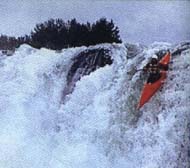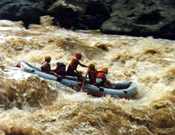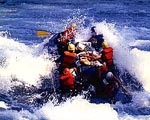|
Guide to Whitewater Rafting in Nepal
In a country like Nepal, a river trip is one of the best ways to explore a typical cross section of the country's natural as well as ethno-cultural heritage. The river is regarded as a form of goddess and used for the purpose of various religious rituals such as cremation under both Hinduism and Buddhism. A variety of cultural activities can be witnessed being performed along the river. The adjoining slopes of the river often harbor dense vegetation and interesting wildlife. Several varieties of fishes also abound the Nepalese rivers.
A foreigner must obtain a permit before going on a river trip. A fee of Rs. 80 (equivalent payable on cash in any convertible foreign currency) must be deposited at the Nepal Rastra Bank, Thapathali, Kathmandu. A copy of documents must be submitted to the Ministry of Tourism, Mountaineering Section, located at Tripureswor behind the Dastrath Stadium. This process could be completed in a day, except on Friday and other half-working days. Normally, your agent does this work for you.
If you have a package tour which does not include a river trip, you can still book one after your arrival in Nepal. If you are doing so, please make sure that the river outfitter you are going to deal with is a registered one. The registered river outfitters are recommended because they possess legal existence. The river outfitter normally provides you with an inclusive trip which includes river permit fee, all meals during the trip, all river equipment (such as inflatable rubber raft, life-vest, water proof camera container, water-proof day bag), both way transportation, all camping equipment such as tent, sleeping bag, mattresses, and so on.
If you start at 7 a.m. and the driver drops you at the put-in point exactly after three hours, rafting is likely to begin around 11 a.m. After you reach the put-in point, a safety talk takes place along with the inflating of the rubber rafts and organizing other river equipment by river crew. The talk includes delivering know-how about measures to be taken in case of an emergency need. The participant should listen to the river guide very carefully. Questions can be raised to make things clearer. The life-vest must be worn all the time while on the river, irrespective of whether you are hitting a major rapid or running a flat water section. A protective helmet is suggested if you are running a high class rapid. Frequently the river outfitter provides the option between an oar or a paddle boat. Kayaking is another option. Normally the kayakers bring their own kayaks. There are outfitters who provide with a kayak, however. If your option is the paddle boat, then you are instructed to properly use the paddle either during the safety talk or before sailing off. If you are of participative nature, then your choice would be paddling. Paddling is more challenging and thrilling. The paddle boat requires well coordinated team effort between the paddlers and river guide who stays at the back and plays his paddle in the role of the steering wheel of a car. The responsibility of the participants is to follow his instruction in a proper manner. The thrilling moment for a paddler is while hitting a rapid. It is usual that you get wet whether you hit a rapid or not within half an hour after sailing starts. In an oar boat, the river guide alone rows lightly and slowly on the flat water and penetratedly and boldly while hitting a rapid. The oar boat gives you an opportunity to observe the surroundings. As for meals, the river outfitter normally provides all meals during the trip days except for the breakfast of the first day.
For a Day Trip - During Autumn (Mid-September through November) and Spring (March-June)
For two days or more, in addition to the above, you are advised to carry extra T shirts, shorts, an extra pair of dry shoes, trousers and a light wool sweater, etc. For a Day Trip - During Winter (December through February)
For a trip involving two days or more, you are advised to carry warm shirts, T shirts, heavy woolen sweater, extra pair of dry shoes and trousers in addition to the above items. You can also carry reading materials, specific medication if required, camera, binoculars, film, pocket knife and flashlight.
Growth in the number of rafters over the years has put some strain on the environment of the rivers and beaches. A little thought and action is required to conserve the river environment. The river outfitters and the rafters can play a role in the conservation by burning down such items as toilet paper, left over food etc. Undisposable items such as tin cans, bottles, could be handed out to the local villagers who could use them for their domestic purpose. While digging a toilet pit, make sure that it is deep enough. Please do not throw any thing about the river. If you care the river, it will be with you forever nice and clean.
|
|||||||||||||||||||||||||||||||||||||||||||||||||||||||||||||||||||||||||||||||||||||||||||||||||||||||||

 River
rafting is journeying on the torrential river on an inflatable rubber
boat. A river trip is often an adventure but not always. An amateur
with a little sense of adventure can equally enjoy it. A river trip
also provides opportunity for geological surveys and fishing. You
are provided with white water life-vest to put on all the time while
on the river. You are also provided with a helmet, when needed.
A trained professional river guide heads the rafting team. Normally,
all camping equipment and meals are provided by the river outfitter.
River
rafting is journeying on the torrential river on an inflatable rubber
boat. A river trip is often an adventure but not always. An amateur
with a little sense of adventure can equally enjoy it. A river trip
also provides opportunity for geological surveys and fishing. You
are provided with white water life-vest to put on all the time while
on the river. You are also provided with a helmet, when needed.
A trained professional river guide heads the rafting team. Normally,
all camping equipment and meals are provided by the river outfitter. There
are trekking agents and river outfitters who operate river trips
in Nepal. These outfitters could be approached in two ways: one
way is through your local agent and the other is to make a direct
contact with any of the outfitters after your arrival in Kathmandu.
There
are trekking agents and river outfitters who operate river trips
in Nepal. These outfitters could be approached in two ways: one
way is through your local agent and the other is to make a direct
contact with any of the outfitters after your arrival in Kathmandu. Normally
the first day of a river trip begins early morning around 7 a.m..
You are driven to the put-in point of the river. Depending upon
the distance between Kathmandu and the put-in point, the drive can
take from a couple of hours to over 4 hours. This is the situation
if you choose between the Trishuli and the Sunkoshi. A river trip
on any other river requires a longer drive or a flight plus drive
and even a trek in some cases.
Normally
the first day of a river trip begins early morning around 7 a.m..
You are driven to the put-in point of the river. Depending upon
the distance between Kathmandu and the put-in point, the drive can
take from a couple of hours to over 4 hours. This is the situation
if you choose between the Trishuli and the Sunkoshi. A river trip
on any other river requires a longer drive or a flight plus drive
and even a trek in some cases.